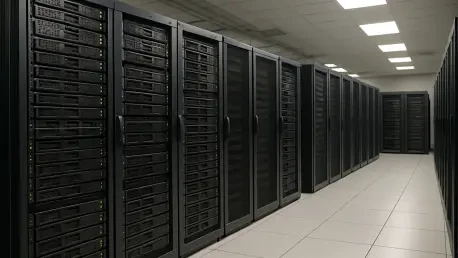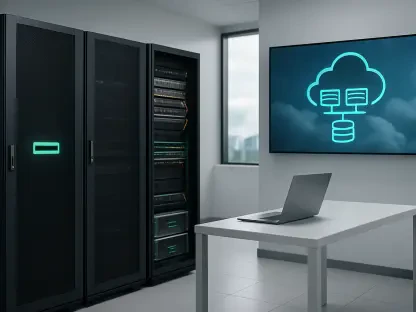I’m thrilled to sit down with Maryanne Baines, a renowned authority in cloud technology with extensive experience evaluating cloud providers, their tech stacks, and how their solutions apply across various industries. Today, we’re diving into the recent enhancements to the InfiniBox G4 Family, a game-changer in high-end enterprise storage. Our conversation will explore the significant upgrades in capacity and efficiency, the impact of a smaller physical footprint, innovative pricing strategies, and the integration of native protocols in storage systems. We’ll also touch on how these advancements cater to specific workloads like backup and address real-world data center challenges. Let’s get started!
Can you give us an overview of the recent refresh to the InfiniBox G4 Family and what makes it stand out?
Absolutely, the InfiniBox G4 Family refresh is a substantial update in the high-end storage space. It’s not just a minor tweak; we’re talking about doubling capacity in some models, shrinking the physical footprint by nearly a third, and slashing entry costs. These changes are driven by hardware upgrades like denser drive enclosures and faster connectivity, alongside software innovations. What stands out is how these enhancements balance performance with practical concerns like space and power, making high-end storage more accessible and efficient for enterprises.
How do these upgrades reshape the way enterprises approach high-end storage solutions?
These upgrades shift the conversation from just raw performance to total value. Enterprises now have to think about how much power and space they’re consuming per terabyte, especially with data center constraints tightening. The G4 refresh offers a compelling argument for consolidating workloads onto a single platform that can handle diverse needs without breaking the bank or the rack. It’s pushing companies to rethink sprawling, inefficient setups and consider streamlined, high-density options that still deliver top-tier performance.
Focusing on the InfiniBox SSA G4 F24, what’s the significance of fitting high-end storage into just 11 rack units?
It’s a huge deal because space is a premium in most data centers. Cutting down to 11 rack units—a 31% smaller footprint than earlier models—means you can pack enterprise-grade storage into tighter environments without sacrificing capability. This design opens up possibilities for businesses that couldn’t previously house such powerful systems due to spatial limitations, making high-end storage a realistic option in more diverse settings.
Which types of businesses or environments do you think will benefit most from this compact design?
I’d say colocation facilities and remote sites are the big winners here. These environments often deal with strict space constraints and need robust storage without the luxury of sprawling racks. Smaller enterprises or branch offices that couldn’t justify the footprint of older high-end systems also stand to gain. This design really targets anyone who’s been priced out or spaced out of top-tier storage solutions until now.
The SSA G4 F24 also comes with a 29% price reduction. How does this lower cost impact potential buyers?
That price drop is a game-changer. It lowers the barrier to entry for high-end storage, making it a viable option for organizations that might have balked at the cost before. Budget-conscious enterprises can now access performance and features that were previously out of reach, without needing to compromise on quality or scalability. It’s a strategic move to democratize access to premium storage tech.
Does this pricing make high-end storage more feasible for smaller enterprises or remote locations?
Definitely. Smaller enterprises and remote locations often operate on tighter budgets and can’t justify the hefty upfront costs of traditional high-end storage. This pricing adjustment means they can invest in a system that grows with them and delivers enterprise-class reliability and performance. It’s about bringing top-tier solutions to a broader audience, which is a smart play in today’s market.
Turning to the hybrid InfiniBox systems, how did they achieve such a massive capacity increase to 33 petabytes effective in a single rack?
That jump—from 17.2 to 33 petabytes effective—is staggering and comes down to a few key innovations. They’ve moved to 78-drive enclosures from the older 60-drive setups, which packs more storage into the same space. They’ve also upgraded to SAS-4 connectivity for faster internal data transfer, and they’re rolling out 24TB hard drives later this year. Together, these changes maximize density and efficiency, allowing a single rack to handle an unprecedented amount of data.
Why is the hybrid system being positioned as an ideal choice for backup workloads?
The hybrid InfiniBox hits a sweet spot for backup because it combines massive capacity with performance features tailored for those workloads. Its ability to handle large-scale data efficiently shortens backup windows, which is critical for businesses with tight schedules. Plus, the one-minute snapshot recovery time objective (RTO) ensures near-instant restoration, minimizing downtime. It’s built to manage the heavy lifting of backup while keeping operations smooth.
Speaking of that one-minute recovery time, how does it affect enterprise backup and restoration processes?
That one-minute RTO is a lifesaver for enterprises. It means that no matter how much data you’ve got stored, you can recover snapshots almost instantly. This drastically cuts down restoration times, which is huge for minimizing disruption during outages or data loss events. It also eases the pressure on backup windows, letting IT teams operate with more flexibility and confidence that they can bounce back fast if something goes wrong.
Let’s talk about the native S3 object protocol support in InfuzeOS. Why is embedding file, block, and object protocols directly into the operating system such a significant step?
Embedding these protocols natively into InfuzeOS simplifies storage management in a big way. Unlike competitors who often tack on these features as afterthoughts, having file, block, and object support built into the core system means seamless integration and fewer management headaches. It allows enterprises to handle mixed workloads without juggling separate tools or layers, streamlining operations and reducing complexity in environments where data access methods vary widely.
With power efficiency being a growing concern, how do the G4 Family’s efficiency claims address real data center challenges?
Power efficiency is no longer just a nice-to-have; it’s a critical issue as data centers ration watts for things like AI deployments. The G4 Family’s claim of being nearly seven times more power-efficient than some competitors, based on public specs, tackles this head-on. Pair that with a smaller footprint and lower power consumption per terabyte, and you’ve got a solution that directly addresses the very real constraints of space and energy in modern data centers.
What is your forecast for the future of high-end storage solutions given these kinds of advancements?
I think we’re heading toward a future where high-end storage becomes even more integrated and accessible. Advancements like those in the G4 Family suggest a trend of packing more power into smaller, cheaper, and more efficient systems. As data demands grow—especially with AI and big data workloads—storage will need to keep pace by offering flexibility for mixed workloads and prioritizing sustainability. I expect we’ll see more native integrations and a push toward democratization, where even smaller players can tap into enterprise-grade tech without the traditional hurdles.









